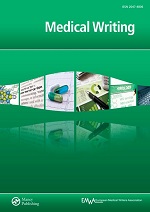
Volume 24, Issue 4 - Writing for Lay Audiences
Elements of storytelling in medical journalism
Author: Sonya Collins
Abstract
Medical journalists marry the techniques of technical medical writing and storytelling in their work. They need a high-level understanding of the science behind the story, but they must also skilfully employ techniques that draw in readers who may feel the topic is too complex for them. Journalists do this by hooking readers with the stories of the real people affected by the science and painting verbal pictures of hard-to-grasp concepts.
 Download the full article
Download the full article
References
- Kowalczyk L. Donor's Death Shatters Family, Stuns Surgeons. The Boston Globe; 2014 Feb 02 [cited 2015 Aug 17]. Available from: http://www.bostonglobe.com/lifestyle/health-wellness/2014/02/02/death-living-liver-donor-calamity-for-two-families-and-lahey/q9iRF9nHyQdewWjvlTgmRI/story.html
- Skloot R. The Immortal Life of Henrietta Lacks. New York: Crown; 2010.
- Study: 270,000 tons of plastic floating in oceans. AP Online; 2014 Dec 10 [cited 2015 Aug 17]. Available from: http://www.wtsp.com/story/news/2014/12/10/study-270000-tons-of-plastic-in-oceans/20231325/
- Trends in Teen Pregnancy and Childbearing. The Office of Adolescent Health, U.S. Department of Health and Human Services; updated 2015 May 29 [cited 2015 Aug 17]. Available from: http://www.hhs.gov/ash/oah/adolescent-health-topics/reproductive-health/teen-pregnancy/trends.html
Search
Articles
Links
Editoral Board
Editor-in-Chief
Co-Editors
Managing Editor
Victoria White
Deputy Managing Editor
Alicia Brooks Waltman
Associate Editors
Section Editors
AI/Automation
Biotechnology
Digital Communication
EMWA News
Freelancing
Gained in Translation
Getting Your Foot in the Door
Good Writing Practice
Pablo Izquierdo / Alison McIntosh
In the Bookstores
Publications
Medical Communications/Writing for Patients
Medical Devices
My First Medical Writing
News from the EMA
Pharmacovigilance
Regulatory Matters
Regulatory Public Disclosure
Louisa Ludwig-Begall / Sarah Kabani
The Crofter: Sustainable Communications
Veterinary Writing
Editors Emeritus
Layout Designer
Chris Monk
 Visit the EMWA website
Visit the EMWA website